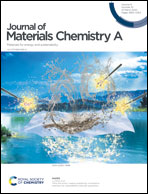Investigating two-step MAPbI3 thin film formation during spin coating by simultaneous in situ absorption and photoluminescence spectroscopy†
Abstract
To date, the two-step processing method represents an attractive route for the thin film formation of halide perovskites. However, a fundamental understanding of the film formation dynamics in the case of spin coating methylammonium iodide (MAI) on PbI2 has not been established yet. Here we apply in situ optical spectroscopy during the two-step film formation of the model halide perovskite MAPbI3via spin coating. We identify and analyze in detail the optical features that occur in the photoluminescence and the corresponding absorption spectra during processing. We find that the film formation takes place in five consecutive steps, including the formation of a MAPbI3 capping layer via an interface crystallization and the occurrence of an intense dissolution–recrystallization process. Consideration of confinement and self-absorption effects in the PL spectra, together with consideration of the corresponding absorption spectra allows quantification of the growth rate of the initial interface crystallization, which is found to be 11 nm s−1 under our processing conditions. We find that the main dissolution–recrystallization process happens at a rate of 445 nm s−1, emphasizing its importance to the overall processing.



 Please wait while we load your content...
Please wait while we load your content...